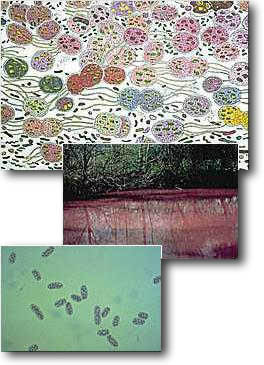| |||||||||

Life's Fortunate Fermenters3700 Million Years Ago
Life is easy for the biosphere's first beings, fermenting a pantry filled with free organic compounds formed in the atmosphere. These anaerobic (living in the absence of oxygen) freeloaders create life's first food crisis: rapidly reproducing, they consume food faster than the atmosphere renews it.
Certain descendants of these fortunate fermenters show notable problem-solving skills: they overcome the food shortage by learning to make their own food. These planetary "primary producers" use light or chemicals to generate energy, fabricating food directly from carbon dioxide.
Green and purple microbes evolve Earth's most important metabolic innovation: photosynthesis.
These early prodigies practice specialized photosynthesis, which gives off sulfur rather than oxygen "waste." Using solar power, the microbes take hydrogen from hydrogen sulfide gas that is spewed out of deep-sea vents and volcanoes and combine it with carbon dioxide to make their bodies.
|
Top: This lake community shows contemporary relatives of Earth's earliest photosynthesizers. Green Chlorobium, the first solar-powered sulfide munchers of the planet, reside here with pink and purple populations of other early non-oxygen photosynthesizers. About 3,700 MYA, the Archean landscape glistened bright green, red, purple, and orange as hydrogen-hungry microbes colonized wet volcanic terrain, pumice, and black sands. (Illustration by Christie Lyons)
Middle: Pollution — NOT! Virtually all lakes harbor descendants of ancient microbes which photosynthesize but cannot tolerate oxygen and thus usually remain in murky depths. Here, at Lake Cisó in Spain, abundant hydrogen sulfide and trees protect the waters from aerating winds, and the healthy Chromatium turn the lake completely pink.(Photograph by Ricardo Guerrero) Bottom: Chromatium swim toward light and their favorite food, hydrogen sulfide gas, and swim away at the slightest whiff of oxygen. Like most bacteria in the wild, they live in interdependent communities of large and varied populations. (Photograph by Norbert Pfennig) |
|
Glossary | Home | Questions or comments, E-mail the Webmaster All contents © Foundation For Global Community |
|